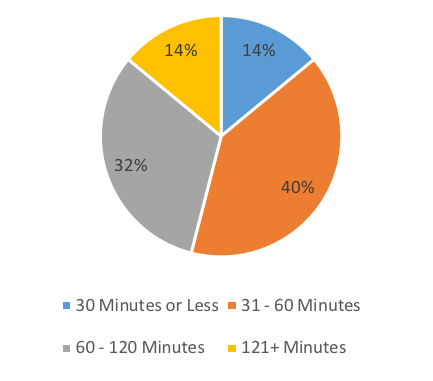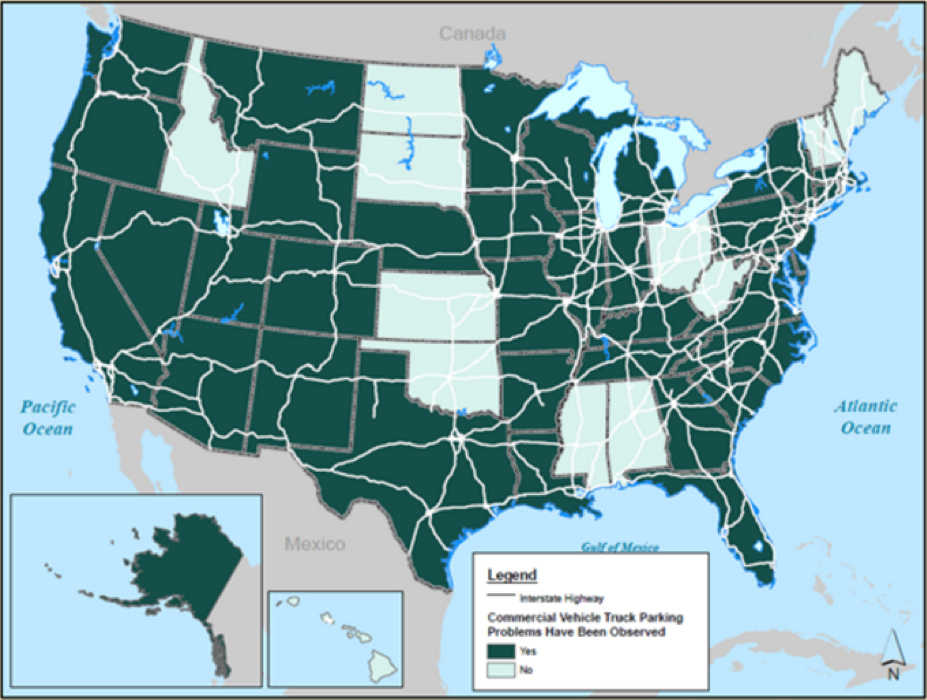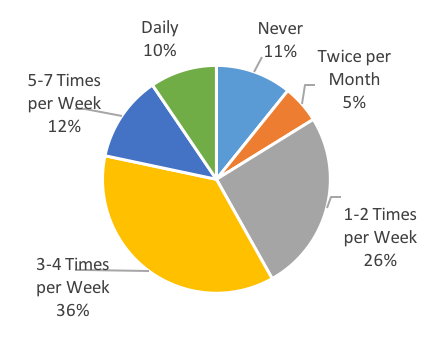Dedicated parking spaces for trucks, at public rest stops and commercial truck stops, serve multiple purposes. Compared to car parking lots, truck lots are relatively rare, may be occupied for longer periods, and have the highest occupancy during late night and early morning, when many drivers observe their federally-required 10-hour rest break. In addition to these overnight parkers, truck parking serves drivers taking shorter breaks, and drivers staging for specific pickup and delivery times at nearby freight generators. A lack of readily available truck parking, particularly at evening peak times when many drivers must stop, may lead to problematic parking behaviors, like trucks parking on shoulders, ramps, and in unauthorized areas. These issues are particularly acute in metropolitan regions where trucks compete for space to “stage” or wait for their delivery windows at local freight facilities.
A full truck parking lot — the Florida 595 Truck Stop near I-595 and Florida’s Turnpike — mid-afternoon on a weekday

The truck parking problem has two aspects: the first is that peak demand is far greater than capacity in some regions, and the second is matching available capacity to demand in places and at times where some facilities are full, but not others. Demand for truck parking often approaches or exceeds supply in urban areas and on high volume truck corridors, at certain times. A 2015 FHWA survey found that 75% of truck drivers reported difficulty finding parking each week, and 72% of state DOTs believed their respective states had some form of truck parking problem. Further, 59% of all states reported truck parking shortages at public rest stops, and 31% of all states reported shortages at private truck stops (FHWA, 2015). Figure 2 6 shows the states in which state DOTs reported truck parking problems.
Parking shortages have a number of negative effects on truck operations, infrastructure condition, and highway safety. First, drivers must either spend more time in search of parking spots or stop when they find a spot before the end of their hours of service, which reduces their productivity. Second, drivers who cannot find parking, or who drive until their hours of service run out may park in unauthorized or undesignated parking areas such as highway ramps and shoulders, or in vacant or abandoned lots. These behaviors can increase the likelihood of collisions, damage to pavements not meant to accommodate parked trucks, and expose drivers to risks of theft and other crime.
Figure 2-7: Average Daily Remaining Driving Time

Multiple surveys have shown that between 33% and 50% of drivers spend more than 30 minutes a day searching for parking (Boris & Brewster, 2016). In addition to time spent searching for parking, drivers may decide to stop early if they believe that parking will not be available farther on their route. An ATRI survey in 2016 estimated that, due to parking availability concerns, 86% of drivers end their day at least 30 minutes early and 46% end at least an hour early. ATRI estimates that stopping early for parking costs the average trucker $4,600 per year in lost productivity (Boris & Brewster, 2016). Figure 2-7 shows the rates at which of truckers choose to stop early due to parking concerns.
States Reporting Truck Parking Problems

Another option for drivers, particularly those approaching their hours of service limits is parking in unauthorized or undesignated areas such as highway ramps and shoulders, and in vacant commercial or industrial lots, as evidenced in the 2016 ATRI survey.
58% of truck drivers reported parking in unauthorized or undesignated parking areas each at least 3-4 times a week.”
Figure 2 8: Unauthorized/Undesignated Parking Frequency

Figure 2-8 shows these rates. Parking in inappropriate areas creates its own problems. Trucks parked on highway shoulders and ramps present a collision hazard, and damage pavements not meant to support parked trucks, while parking in vacant or abandoned lots may elevate a trucker’s exposure to criminal activity, such as theft.